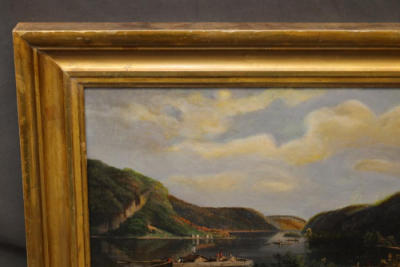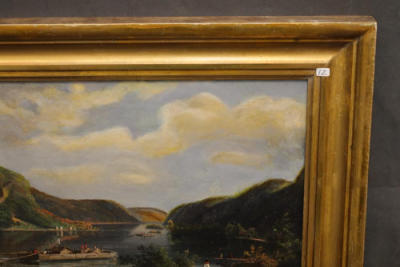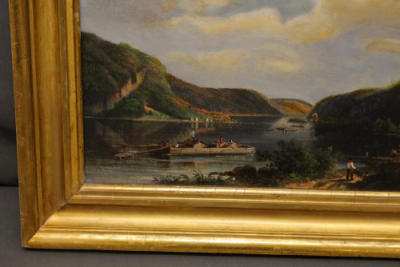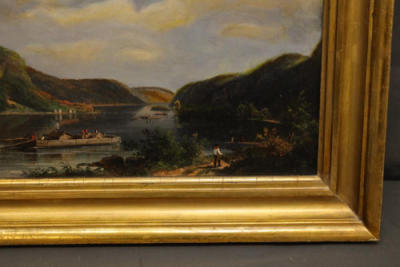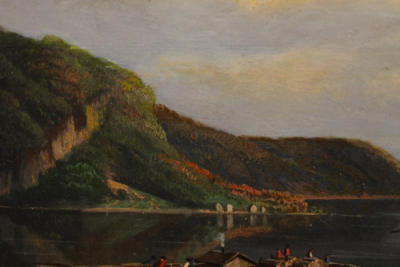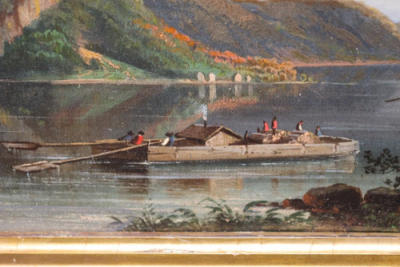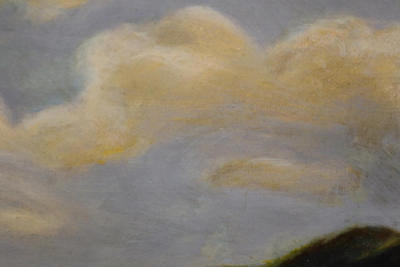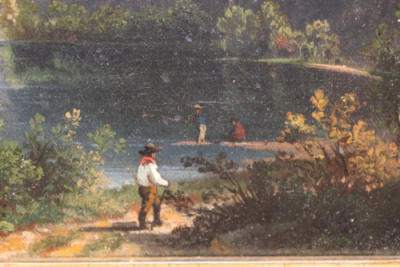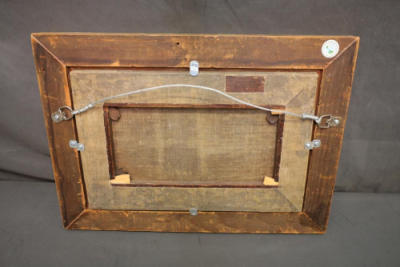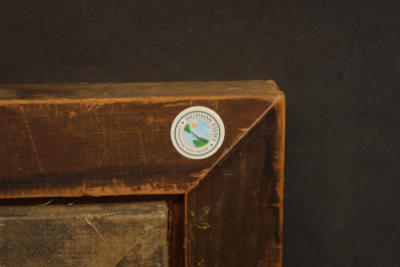This curated auction of Hudson River Paintings for sale is from the personal collection of Robert & Susan Doyle of Fishkill, NY. The Doyle's are offering thirty-seven American 19thC Hudson River School paintings at auction. All Hudson River paintings in this sale are original works and almost all have been professionally cleaned and conserved. The first American School of Art is known as "The Hudson River School," consisting of mid nineteenth century "Nature Painters" who found spirituality in nature. These adventuresome Hudson River artists hiked to see impressive views. They sketched and did studies in the field to bring back to their studios to create finished paintings. The Hudson River served as the main route of travel to the best places, as well as provided the best subject matter. New York City, with the National Academy of Design to exhibit at, was the center of the American Arts world in the 19thC. These "Nature Painters" celebrated and depicted the pristine magnificence of the American landscape of the 19th Century on their canvases. Now you can experience the beauty, tranquility and grandness of Nature from the first American School of Art; the Hudson River School. Register and Bid now! Artwork is on display at the Absolute Auction Center in Pleasant Valley, NY.
Payment is due by Friday, December 13 at 1PM. All lots subject to seller approval.
Information with payment and pickup instructions will be emailed to winning bidders the morning after the auction ends.
Pickup is by appointment only and must be completed by Friday, December 13 at 3PM.
All lots sold as is, where is. There is a 18% Buyers Premium for all lots purchased. Payment methods for non-vehicle & non-equipment is cash, Visa, Master Card or Discover card.
Preview available online 24 hours or by appointment only. To schedule, contact our office at 845-635-3169, option 7.
Items are located at the Absolute Auction Center: 45 South Ave, Pleasant Valley, NY 12569.
Click More Info/Bid Now for additional photos.
Payment is due by Friday, December 13 at 1PM. All lots subject to seller approval.
Information with payment and pickup instructions will be emailed to winning bidders the morning after the auction ends.
Pickup is by appointment only and must be completed by Friday, December 13 at 3PM.
All lots sold as is, where is. There is a 18% Buyers Premium for all lots purchased. Payment methods for non-vehicle & non-equipment is cash, Visa, Master Card or Discover card.
Preview available online 24 hours or by appointment only. To schedule, contact our office at 845-635-3169, option 7.
Items are located at the Absolute Auction Center: 45 South Ave, Pleasant Valley, NY 12569.
Click More Info/Bid Now for additional photos.
Auction Info
This curated auction of Hudson River Paintings for sale is from the personal collection of Robert & Susan Doyle of Fishkill, NY. The Doyle's are offering thirty-seven American 19thC Hudson River School paintings at auction. All Hudson River paintings in this sale are original works and almost all have been professionally cleaned and conserved. The first American School of Art is known as "The Hudson River School," consisting of mid nineteenth century "Nature Painters" who found spirituality in nature. These adventuresome Hudson River artists hiked to see impressive views. They sketched and did studies in the field to bring back to their studios to create finished paintings. The Hudson River served as the main route of travel to the best places, as well as provided the best subject matter. New York City, with the National Academy of Design to exhibit at, was the center of the American Arts world in the 19thC. These "Nature Painters" celebrated and depicted the pristine magnificence of the American landscape of the 19th Century on their canvases. Now you can experience the beauty, tranquility and grandness of Nature from the first American School of Art; the Hudson River School. Register and Bid now! Artwork is on display at the Absolute Auction Center in Pleasant Valley, NY.
Payment is due by Friday, December 13 at 1PM. All lots subject to seller approval.
Information with payment and pickup instructions will be emailed to winning bidders the morning after the auction ends.
Pickup is by appointment only and must be completed by Friday, December 13 at 3PM.
All lots sold as is, where is. There is a 18% Buyers Premium for all lots purchased. Payment methods for non-vehicle & non-equipment is cash, Visa, Master Card or Discover card.
Preview available online 24 hours or by appointment only. To schedule, contact our office at 845-635-3169, option 7.
Items are located at the Absolute Auction Center: 45 South Ave, Pleasant Valley, NY 12569.
Click More Info/Bid Now for additional photos.
Payment is due by Friday, December 13 at 1PM. All lots subject to seller approval.
Information with payment and pickup instructions will be emailed to winning bidders the morning after the auction ends.
Pickup is by appointment only and must be completed by Friday, December 13 at 3PM.
All lots sold as is, where is. There is a 18% Buyers Premium for all lots purchased. Payment methods for non-vehicle & non-equipment is cash, Visa, Master Card or Discover card.
Preview available online 24 hours or by appointment only. To schedule, contact our office at 845-635-3169, option 7.
Items are located at the Absolute Auction Center: 45 South Ave, Pleasant Valley, NY 12569.
Click More Info/Bid Now for additional photos.
Categories:
19thC Framed Emil Bott (1827-1908) Landscape of River Activity. Oil on canvas Attributed to Emil Bott (German-American, 1827-1908) inscribed Bott in reversed script on the top stretcher. This is a wonderful, small painting depicting lots of activity on a river, most likely in Pennsylvania or Ohio based on his extensive Bio. AskArt Bio: Emil von Bott, born in Wuerttemberg, Germany, July 24, 1825*, came to America with his father, Adolph, in 1848**. The 1850 census of Beaver County, Pa. shows he was married to Emma (Bocking) and they were residing in Phillipsburgh Borough, Beaver County, Pennsylvania. It is likely that soon after coming to this country, he began teaching at a private school in New Brighton, Pa., and there he met Emma, the daughter of another artist, Adolph Bocking. One of Bott's early works, a lithograph, is dated 1851. His painting of Beaver Falls was done in 1854. He once stated that Philadelphia and New York capitalists got him to paint the picture of the Patterson estate, now Beaver Falls, because they intended to build a town there to rival Pittsburgh. Most biographies offer that Bott returned to Germany at some point and studied at the Dusseldorf Academy. If this occured, the time cannot be discerned because it is a fact that Emil Bott appears in every federal census of Beaver County from 1850 until his death. It seems more likely that any study at Dusseldorf was undertaken prior to his immigration to the U.S. at the age of 23. In 1859, Bott exhibited at the first show of the Pittsburgh Art Association. He apparently painted in Pittsburgh, as well as in a multitude of other locations. But that he ever moved his family from Beaver County is not supported by the census records. Bott's exact whereabouts during the Civil War (1861-1865) have largely been ignored but he was, in fact, commissioned as a 1st Lieutenant and Adjutant, Feb. 5, 1862, in the First W. Va. Light Artillery, under Captain Philip Daum. However, after he was somehow separated from his regiment a few months later, he left the service. Since a number of his pencil drawings - "steel engravings" - appear in various Civil War history books, such as Leslie's "Illustrated Famous Leaders and Battle Scenes of the Civil War" and in "Harper's Weekly," it is apparent that he spent considerable time with the troops during the war. Accounts vary as to where Bott lived and worked in the post-war years. Supposedly, he rode the packet boats - "doing decorations" - which means he was painting on the interior walls of the steamboats. And there are many examples of this magnificent work. But, again, he seems to have worked in various locations, with the family remaining in Beaver County. Bott is named as an artist in "Caldwell's Illustrated, Historical, Centennial Atlas of Washington County, Pennsylvania," 1876. And the list of his work goes on, with the clear indication that the Bott family was adequately sustained for many years by his work as an artist. Sometime between 1880 and 1899, Emil lived for twelve years*** in Canton, Ohio, working as both a portrait artist and an artist for the Diebold Safe Works Company. He is listed in the Canton City Directory for the years 1888-1892. But by 1891, still in Canton, he was facing indigency and applied to the Federal Government for a Civil War pension. However, the sparse records of his service were in conflict with his own version of events and no pension was awarded. In short, he had no proof that he had served at least ninety days. The pleas of a desperate and angry man are contained in his file at the National Archives. His wife had died in 1899, and alone and penniless, he fought until almost the end of his life to obtain a pension he believed he deserved. Emil Bott has long been regarded as one of Pittsburgh's most important artists of the mid-1800s. However, his life was a struggle, particularly toward the end. In 1906 he was again living in Canton, probably with his daughter, but later that year he was a resident of the Beaver County Home, also known as "the poor house." He died there on March 16, 1908; the cause of death was, "old age and general debility." Emil Bott's grave in St. Peter's Church Cemetery (Old German Lutheran Cemetery), Monaca, Pa., was unmarked for many decades until Monaca funeral director, Alvin Batchelor, with a long-time interest in the life of Emil Bott, placed a marker on the grave with the inscription, "Emil Bott, The Painter." Of course, Emil Bott was more than a painter. He was a renowned artist, a Civil War soldier and, in combination, a Civil War artist. Although he served for only a few months as a soldier, his many drawings have memorialized scenes of the Civil War. Emil Bott was a long-time resident of Beaver County, PA. and is probably best known in the area for his celebrated landscape painting of Beaver Falls. Emil Bott died in the poorhouse in Beaver County in 1908. Ironically, his art is prominently displayed in the Carnegie Museum, the Westmoreland Museum of Art, the Merrick Art Gallery and many other galleries of Fine Art, as well as in private collections. After gathering together these facts about the life of Emil Bott, it seemed appropriate to finally recognize Emil Bott's Civil War service in the 1st W.Va. Light Artillery. On December 9, 2001, a government marker, mounted on granite, was placed on his grave, with the assistance of David Aeberli of McDonald-Aeberli Funeral Home, Mars, Pa. Sight: 8.75x14”, Overall: 13.5x18.5”. Auction Record: $17,612. Estimate: $6,000-$12,000. (See multiple photos for details and condition.)
More Details
19thC Framed Emil Bott (1827-1908) Landscape of River Activity. Oil on canvas Attributed to Emil Bott (German-American, 1827-1908) inscribed Bott in reversed script on the top stretcher. This is a wonderful, small painting depicting lots of activity on a river, most likely in Pennsylvania or Ohio based on his extensive Bio. AskArt Bio: Emil von Bott, born in Wuerttemberg, Germany, July 24, 1825*, came to America with his father, Adolph, in 1848**. The 1850 census of Beaver County, Pa. shows he was married to Emma (Bocking) and they were residing in Phillipsburgh Borough, Beaver County, Pennsylvania. It is likely that soon after coming to this country, he began teaching at a private school in New Brighton, Pa., and there he met Emma, the daughter of another artist, Adolph Bocking. One of Bott's early works, a lithograph, is dated 1851. His painting of Beaver Falls was done in 1854. He once stated that Philadelphia and New York capitalists got him to paint the picture of the Patterson estate, now Beaver Falls, because they intended to build a town there to rival Pittsburgh. Most biographies offer that Bott returned to Germany at some point and studied at the Dusseldorf Academy. If this occured, the time cannot be discerned because it is a fact that Emil Bott appears in every federal census of Beaver County from 1850 until his death. It seems more likely that any study at Dusseldorf was undertaken prior to his immigration to the U.S. at the age of 23. In 1859, Bott exhibited at the first show of the Pittsburgh Art Association. He apparently painted in Pittsburgh, as well as in a multitude of other locations. But that he ever moved his family from Beaver County is not supported by the census records. Bott's exact whereabouts during the Civil War (1861-1865) have largely been ignored but he was, in fact, commissioned as a 1st Lieutenant and Adjutant, Feb. 5, 1862, in the First W. Va. Light Artillery, under Captain Philip Daum. However, after he was somehow separated from his regiment a few months later, he left the service. Since a number of his pencil drawings - "steel engravings" - appear in various Civil War history books, such as Leslie's "Illustrated Famous Leaders and Battle Scenes of the Civil War" and in "Harper's Weekly," it is apparent that he spent considerable time with the troops during the war. Accounts vary as to where Bott lived and worked in the post-war years. Supposedly, he rode the packet boats - "doing decorations" - which means he was painting on the interior walls of the steamboats. And there are many examples of this magnificent work. But, again, he seems to have worked in various locations, with the family remaining in Beaver County. Bott is named as an artist in "Caldwell's Illustrated, Historical, Centennial Atlas of Washington County, Pennsylvania," 1876. And the list of his work goes on, with the clear indication that the Bott family was adequately sustained for many years by his work as an artist. Sometime between 1880 and 1899, Emil lived for twelve years*** in Canton, Ohio, working as both a portrait artist and an artist for the Diebold Safe Works Company. He is listed in the Canton City Directory for the years 1888-1892. But by 1891, still in Canton, he was facing indigency and applied to the Federal Government for a Civil War pension. However, the sparse records of his service were in conflict with his own version of events and no pension was awarded. In short, he had no proof that he had served at least ninety days. The pleas of a desperate and angry man are contained in his file at the National Archives. His wife had died in 1899, and alone and penniless, he fought until almost the end of his life to obtain a pension he believed he deserved. Emil Bott has long been regarded as one of Pittsburgh's most important artists of the mid-1800s. However, his life was a struggle, particularly toward the end. In 1906 he was again living in Canton, probably with his daughter, but later that year he was a resident of the Beaver County Home, also known as "the poor house." He died there on March 16, 1908; the cause of death was, "old age and general debility." Emil Bott's grave in St. Peter's Church Cemetery (Old German Lutheran Cemetery), Monaca, Pa., was unmarked for many decades until Monaca funeral director, Alvin Batchelor, with a long-time interest in the life of Emil Bott, placed a marker on the grave with the inscription, "Emil Bott, The Painter." Of course, Emil Bott was more than a painter. He was a renowned artist, a Civil War soldier and, in combination, a Civil War artist. Although he served for only a few months as a soldier, his many drawings have memorialized scenes of the Civil War. Emil Bott was a long-time resident of Beaver County, PA. and is probably best known in the area for his celebrated landscape painting of Beaver Falls. Emil Bott died in the poorhouse in Beaver County in 1908. Ironically, his art is prominently displayed in the Carnegie Museum, the Westmoreland Museum of Art, the Merrick Art Gallery and many other galleries of Fine Art, as well as in private collections. After gathering together these facts about the life of Emil Bott, it seemed appropriate to finally recognize Emil Bott's Civil War service in the 1st W.Va. Light Artillery. On December 9, 2001, a government marker, mounted on granite, was placed on his grave, with the assistance of David Aeberli of McDonald-Aeberli Funeral Home, Mars, Pa. Sight: 8.75x14”, Overall: 13.5x18.5”. Auction Record: $17,612. Estimate: $6,000-$12,000. (See multiple photos for details and condition.)
Closes On: Dec 11, 2024
08:05:30 PM – 08:06:00 PM EST
High Bid:
$2,200.00 – huds0n
Auction Type: One Lot
Quantity: 1
Login to Bid















